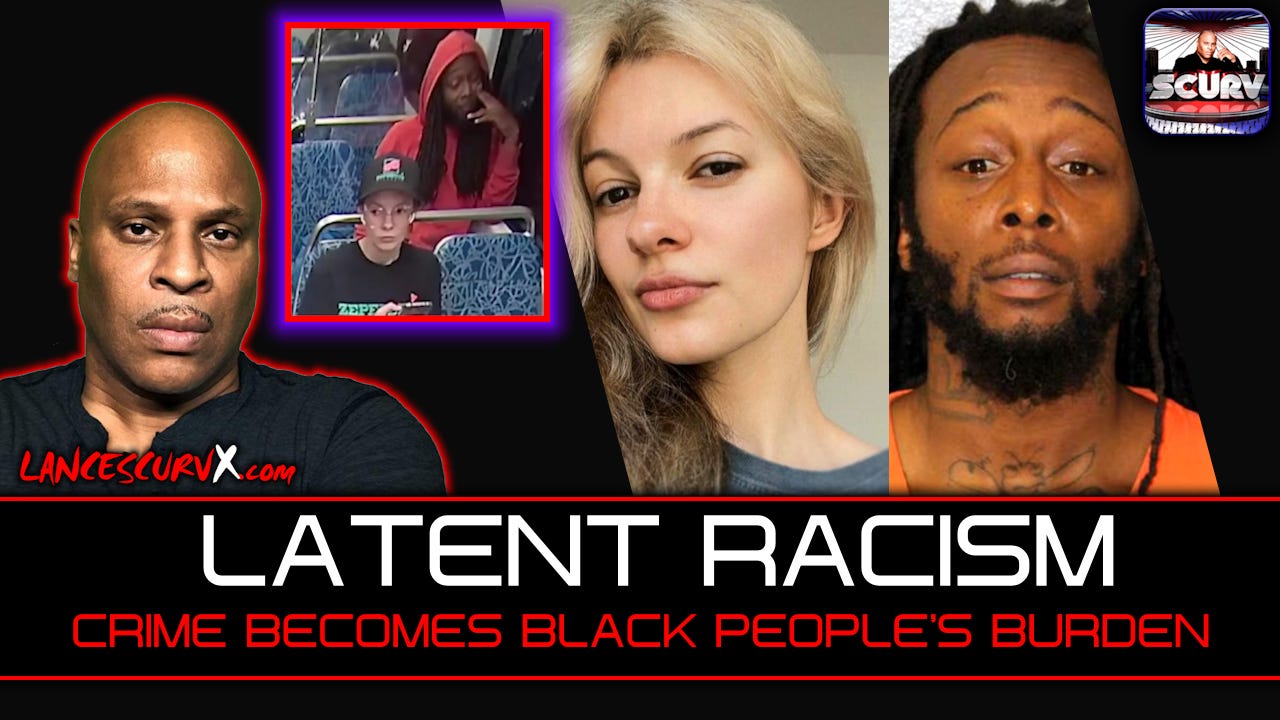LATENT RACISM: WHY ONE CRIME BECOMES A WEAPON AGAINST BLACK PEOPLE...
On August 22, 2025, tragedy struck on the Lynx Blue Line light rail in Charlotte, North Carolina. Iryna Zarutska, a 23-year-old Ukrainian refugee who had fled the war in her homeland just three years earlier, was simply trying to get home from work. She never made it.
While sitting quietly on the train, she was attacked without warning by Decarlos Brown Jr., a 34-year-old man with a long criminal history and a documented struggle with mental illness. After only a few minutes on board, Brown stood up and fatally stabbed Iryna multiple times, ending her life in front of stunned passengers.
Investigators later revealed that Brown suffered from schizophrenia and claimed that he believed people — including Iryna — were “reading his mind.” Despite his condition, he had been released back into society after more than a dozen prior cases, raising questions about how someone with such a record and instability could be free without proper supervision or treatment.
Brown now faces first-degree murder charges in North Carolina, as well as potential federal charges since the killing happened on a mass transportation system. If convicted federally, he could face the death penalty.
This horrific event has shaken not only Charlotte but also the wider public, sparking debates about mental health failures, weak bail systems, repeat offenders, and the safety of everyday people who simply want to ride public transportation in peace. For many, Iryna’s murder is not an isolated tragedy, but a painful reminder of what happens when society ignores warning signs until it’s too late.There are times when a single event is used to expose the ugly truths of society. A tragedy takes place, and instead of mourning the victim, many rush to use it as fuel for their own hidden hatred.
In this case, a young woman lost her life in a brutal act. She was innocent. She did not deserve it. The man who attacked her should have never been free in the first place. That alone is enough to be angry about. Yet, what followed in the reaction of so many revealed something even darker.
Across comment sections and conversations, people were not only grieving for the woman. They were also attacking an entire race of people. To them, this was not about one man and his crime. It was about a Black man and a white woman. That pairing unleashed something ugly and familiar.
The truth is that for many white people, a Black man harming a white woman is the ultimate nightmare scenario. It awakens an old stereotype that has been used for centuries to justify violence, lynching, and control over Black lives.
My expressions here is not to excuse the killer. He was evil. This is about the way the response itself exposed the deep racism still rooted in the hearts of many. It is about how one crime was turned into an excuse to demonize an entire community, while countless crimes against Black people are ignored.
The Latent Racism
When Black people are harmed, the world rarely responds with the same intensity. A Black woman can be killed, and her story disappears within days. The same grief, compassion, and emotional outpouring are not given to her memory. Her pain is treated as ordinary, almost expected.
But when a white woman suffers, especially at the hands of a Black man, the reaction is explosive. People speak with passion, rage, and disgust. They turn the crime into proof that Black men are violent, dangerous, and inhuman. The tragedy becomes a weapon.
This is not a new pattern. History shows us the same narrative in films like The Birth of a Nation by D.W. Griffith. Black men were painted as wild beasts threatening white women. That lie gave birth to decades of lynchings and racial terror. The same stereotype is being replayed today.
What makes this worse is the silence when Black lives are destroyed. For centuries, from slavery to segregation to police brutality today, the suffering of Black people has been met with excuses, cover-ups, or no coverage at all. White society rarely weeps for us. Yet, they demand we accept their grief and outrage whenever a tragedy touches them.
This is the double standard that cannot be ignored. Their compassion is selective. Their empathy has boundaries. And their racism bleeds out through the very way they react.
Why Race is the Focus
People could have seen this crime for what it was: an evil man attacking an innocent woman. Race did not need to be the center of the story. But for many, it always will be.
In their minds, the race of the killer mattered more than the crime itself. It confirmed their old fears. It made them feel justified in their hatred. To them, this was not about safety or justice. It was about power.
The real fear was never about protecting women. If it were, society would show the same rage when Black women are victimized. The fear is about Black men breaking the invisible rules that white supremacy has enforced for centuries.
This reveals how deeply racism is built into the structure of America and beyond. It is not only in the systems of policing, housing, and economics. It is also in the emotions, the reflexes, and the hidden instincts of white people.
When they cry out in anger at one incident but ignore centuries of pain we have suffered, it shows where their hearts truly stand.
A Long History of Weaponizing Lies
The reaction to this crime is not new — it is part of a cycle that has claimed countless Black lives.
Take Emmett Till, a 14-year-old boy lynched in Mississippi in 1955. A white woman accused him of whistling at her. That lie led to his brutal murder. Decades later, she admitted she made up the story. Yet Emmett’s life was stolen, and his death became a symbol of how dangerous this stereotype is.
Go back further to the early 20th century, and you will find thousands of lynchings across the South. Many of them were justified by claims that a Black man had looked at, spoken to, or been near a white woman. These accusations rarely needed proof. The stereotype itself was enough to trigger mob violence.
Even before that, during slavery, the same narrative was used. Enslaved Black men were portrayed as threats to white women, while in reality, it was white enslavers who raped, abused, and brutalized Black women with no consequence. The lie of the “Black male predator” was always a cover for white violence and control.
This history connects directly to today. Every time a crime involving a Black man and a white woman happens, these old lies are pulled out of the grave and revived. It is not just about one case. It is about a legacy of racial fear that continues to poison minds and policies.
The Silence Around Black Women
Here is where the hypocrisy is most painful. When a white woman is harmed, the nation mourns. Her story is told in detail. Strangers express grief and anger. But when a Black woman is killed, too often the silence is deafening.
Look at the countless missing and murdered Black women whose names never trend, whose stories rarely make headlines. Families cry for justice, but society does not rally behind them. Their pain is treated as background noise.
This invisibility is not accidental. It reflects the way Black women have been dehumanized for centuries. During slavery, they were both laborers and victims of sexual violence. During segregation, their suffering was ignored while their labor was exploited. Today, their vulnerability is still erased in public conversations.
The absence of compassion for Black women stands in stark contrast to the outrage for white women. This imbalance exposes the racial hierarchy of empathy. It shows whose lives are valued and whose are not.
Until society can grieve a Black woman with the same intensity it grieves a white woman, we cannot speak of true justice or equality.
The Ongoing Double Standard
For white people, one crime is enough to confirm their beliefs about us. But for us, four hundred years of slavery, lynching, exploitation, and systemic oppression are still not enough to justify our anger. When we speak out, we are called hateful, racist, or dangerous.
This is the cruel double standard. Their hatred is always seen as natural, justified, or righteous. Our anger is always painted as threatening. Their tears are respected. Our tears are dismissed.
Look at how nations in Africa are robbed and stripped of resources. Look at how Haiti is punished for daring to fight for freedom. Look at how Black Americans are still redlined, brutalized by police, and denied fair access to housing and wealth. These are not accidents. These are systems.
Yet when we call out these truths, we are told to be quiet. We are told to forgive. We are told not to see race. But the same people who say “don’t see race” are the very ones who explode with rage the moment race can be used against us.
This is hypocrisy at its core.
The crime against this young woman was evil. That cannot be denied. She deserved to live, and her killer deserves punishment. But what followed exposed something larger than one crime. It revealed the sickness of racism that still poisons society.
The truth is that white outrage is not really about justice. It is about fear, control, and the maintenance of an old stereotype. They cannot see a Black man without the shadow of that image forced into their minds. They cannot see us as human first.
For centuries, we have carried the weight of their violence, their lies, and their dehumanization. Yet, we are still the ones called savage. We are still the ones called animal. The projection is staggering.
If one incident can justify their hatred, then what do they expect us to feel after centuries of oppression? Their empathy is selective, their humanity conditional. That is the truth we must face.
In the end, this crime shows us more than just the evil of one man. It shows us how deeply racism still runs. It is a reminder that until the world values Black life equally, justice and humanity will never be balanced.






